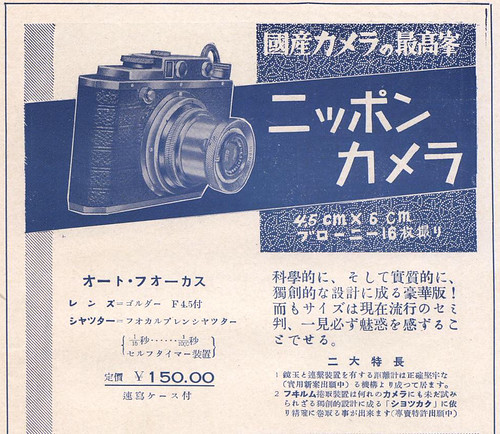Nippon (4.5×6)
The Nippon or Nippon Camera (ニッポンカメラ) is a Japanese 4.5×6 rangefinder camera, distributed from 1936 by Mizuno Shashinki-ten.[1] It is not to be confused with the similarly named Leica copy by Kōgaku Seiki (later Nicca), pictured for example on this page.
Contents
General features
The Nippon has a coupled rangefinder and a focal plane shutter, and it is possibly the only such camera in 4.5×6 format. Two versions exist, sharing the same basic body and presumably the same internals but differing by the arrangement of the top plate. Both have automatic stop advance. It seems that the Nippon has no engraving that would help to identify it, except on the lens cap.
Advertisements and other documents
The Nippon has been observed in two advertisements dated March and October 1937,[2] each showing a different version. Both were inserted by Mizuno, and give a price of ¥150. The price is elevated for the time but not excessive considering that the Hansa Canon was offered the same year for ¥275.[3]
The April advertisement describes the features of the camera, and has the motto "Purely national auto-focus" (純国産オートフォカス), where "auto-focus" refers to the coupled rangefinder. The camera is again called "auto-focus" in the other advertisement. The word Nippon means "Japan" and is normally written 日本, but in the product's name it is consistently written ニッポン in katakana syllables.
The list of set prices compiled in October 1940 and published in January 1941, listed a "Nippon Camera" for ¥248.[4] It is placed in the same category as other high-end medium-format models, such as the Auto Semi Minolta, Weha Chrome Six or Lord. This might indicates that this model is the 4.5×6cm Nippon, not the later 24×36mm Nippon.
No surviving example of the Nippon has been observed yet, and it is not known if it was really sold.
Early version
The early version looks somewhat like an overgrown Leica III. There is a short top housing containing the viewfinder and coupled rangefinder. The viewfinder window is rectangular in the middle and is surrounded by the two round rangefinder windows. The parts of the top plate that are not covered by this housing or by another control are leather covered.
The advance knob is on the left end of the top plate and contains a folding part that acts as a key. It seems that the shutter release is a plunger on the right of the finder housing. The shutter speed selector is a little bit more to the right; it is a rotating speed selector similar to the one found on contemporary Leica models but bigger. The shutter has 1/15 to 1/1000 speed settings. There is a small button on the front, placed like the slow speed selector of the Leica III but it is smaller and it perhaps controls the self-timer.
Late version
The late version has an all chrome top plate and a larger top housing that extends below the speed selector. The rangefinder windows are roughly at the same place as before, but the viewfinder window has moved so that it is between the rangefinder and the speed selector. The rest of the controls is similar except that the plunger possibly acting as a shutter release seems to have moved.
Lens equipment
The lens pictured in the advertisements is collapsible and has helical focusing, but it is unknown if it is interchangeable. It is probably called Goldar Anastigmat, but the Roman spelling is unsure.[5] It is advertised as having four elements. Its maximal aperture is f/4.5 and its focal length seems to be 75mm. There is a lens cap written Nippon.
The company Fuji Kōgaku used the same Goldar or Golder name on four-element lenses equipping some versions of the prewar Lyra Flex and Semi Lyra. It is possible that this company also made the lens of the Nippon, or even the Nippon body.

|
| Early version of Nippon Camera, Advertisement from "Amateur Camera" published in December, 1936 image by Inugami Mamoru (Image rights) |

|
| Late version of Nippon Camera, Advertisement from "昭和12年版躍進写真界総覧" (YakushinSyashinkaiSoran,1937) image by Inugami Mamoru (Image rights) |
Notes
- ↑ Dates: advertisements listed in Kokusan kamera no rekishi, p.338.
- ↑ Advertisements published in Asahi Camera, reproduced in Kokusan kamera no rekishi, p.81.
- ↑ Advertisement for the Hansa Canon published in the May 1937 issue of Asahi Camera, reproduced in Kokusan kamera no rekishi, p.66.
- ↑ "Kokusan shashinki no kōtei kakaku", type 3, section 9.
- ↑ Goldar is inferred from the katakana ゴルダー, that could as well correspond to Golder, Golda, Gorda or some other variation.
Bibliography
- Asahi Camera (アサヒカメラ) editorial staff. Shōwa 10–40nen kōkoku ni miru kokusan kamera no rekishi (昭和10–40年広告にみる国産カメラの歴史, Japanese camera history as seen in advertisements, 1935–1965). Tokyo: Asahi Shinbunsha, 1994. ISBN 4-02-330312-7. Item 164.
- Camera Club. Saishin shashinki zenshū (最新写真機全集, Compendium of the latest cameras.) Supplement to the October 1936 issue. Advertisement on the second cover.
- The Japanese Historical Camera. 日本の歴史的カメラ (Nihon no rekishiteki kamera). 2nd ed. Tokyo: JCII Camera Museum, 2004. p.24. (Listed as a focal-plane shutter with a self-timer; no mention of the rangefinder, etc.)
- "Kokusan shashinki no kōtei kakaku" (国産写真機の公定価格, Set prices of the Japanese cameras), listing Japanese camera production as of October 25, 1940 and setting the retail prices from December 10, 1940. Published in Asahi Camera January 1941 and reproduced in Shōwa 10—40nen kōkoku ni miru kokusan kamera no rekishi (昭和10〜40年広告にみる国産カメラの歴史, Japanese camera history as seen in advertisements, 1935—1965). Tokyo: Asahi Shinbunsha, 1994. ISBN 4-02-330312-7. Pp.108—9. Type 3, section 9.
- Lewis, Gordon, ed. The History of the Japanese Camera. Rochester, N.Y.: George Eastman House, International Museum of Photography & Film, 1991. ISBN 0-935398-17-1 (paper), 0-935398-16-3 (hard). P.53 (brief mention only).
The Nippon (4.5×6) is not listed in Sugiyama.
Links
In Japanese: